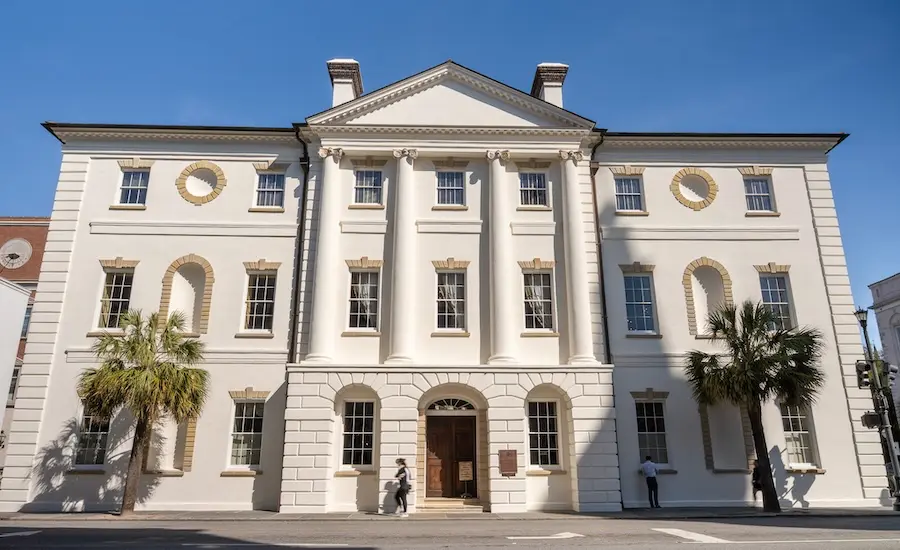One of Charleston, South Carolina’s famed “Four Corners of Law” was recently restored to its former glory.
The nearly 275-year-old Charleston County Courthouse underwent extensive stucco repair, waterproofing and masonry work as part of a roughly $2.5-million restoration that took 13 months and was completed in February. According to an article in Engineering News-Record, Greensboro, N.C.-based restoration contractor WxTite oversaw the work and even sourced period brick from a nearby project via Facebook Marketplace.
Constructed in 1753 at the intersection of Broad and Meeting Streets, the courthouse joins the other three buildings located at the intersection and representing the “Four Corners of Law”: municipal, county, federal, and ecclesiastical (church law).

The other three “Corners” are Charleston City Hall, the U.S. Post Office and Courthouse, and St. Michael’s Episcopal Church. According to the Library of Congress, the nickname for the four buildings is believed to have been coined by Robert Ripley, the name and brains behind the Believe It or Not! franchise.
The county courthouse was originally used as a statehouse for the British Royal government for the South Carolina colony. It was partially destroyed in a fire in 1788, but was reconstructed with a third-floor addition and update in 1792.
The courthouse underwent numerous other changes and additions over the decades, before being restored to its historical 1792 Neoclassical appearance in 2001. It currently houses the Charleston County Probate Court.
When WxTite began its work, the courthouse was suffering from extensive stucco delamination, water intrusion, and other issues associated with its advanced age.
“Part of the process of figuring out how to restore this building, it was trying to figure out what has been done in the past,” WxTite Regional Manager Jamie Donaldson said in a video the company released about the restoration project. “That was a big part of our project was trying to figure out what was done, why they did it, how they did it, what they messed up during the process of the original renovation. Because the reason we’re here is because it wasn’t done perfectly, and our goal is to do this renovation perfectly.”
To address the water intrusion, the project team removed bluestone pavers around the building to install subgrade waterproofing installation. The pavers were then returned to their exact previous locations.
700 s.f. of stone surfaces were carefully repaired and cleaned to bring the exterior of the courthouse back to life. And all 83 of the building’s fenestrations – windows, doors and other openings – were restored to preserve the architectural uniqueness of the structure.
To help protect the courthouse from Mother Nature, 3,000 new hurricane anchors were installed.

“We had a lot of assumptions about what needed to be done,” said WxTite Superintendent Cole Anderson. “But until we really started with the demolition portion of the stucco, we didn’t know how intense the brick repair was going to need to be. It was a lot of kind of opening things up to find out what depth of repair would be needed.”
Donaldson told ENR that the restoration project presented different challenges throughout the project lifecycle – but safety remained of paramount concern from the first day to the final day on-site.
“It’s a famous, busy intersection, arguably one of the busiest intersections in Charleston,” he explained. “Keeping everybody safe was paramount with what we were having to do out there, and still allowing the courthouse to be open and operational during the whole construction.”
At GPRS, safety is always on our radar. We’re committed to helping you ensure the safety of every project you undertake. Whether you’re restoring a historic structure, building a new facility, or managing the buried infrastructure on a site, we’re with you every step of the way – providing solutions to your problems from initial planning to O&M with our subsurface damage prevention, existing conditions documentation, and construction & facilities project management services.
GPRS Intelligently Visualizes The Built World® to keep your projects on time, on budget, and safe.
What can we help you visualize?
Frequently Asked Questions
Does GPRS Perform S.U.E. Work?
No, we do not. We use SUE Level 2-equivalent methodology and equipment to locate underground utilities with an accuracy rate of 99.8%. While we don’t conduct SUE work ourselves, our services allow a SUE Level 1 investigation to be performed more efficiently, eliminating the need to waste thousands of dollars on exploratory potholing.
What Type of Informational Output is Provided When GPRS Locates Utilities for Me?
Our Project Managers flag and paint our findings directly on the surface. This method of communication is the most accurate form of marking when excavation is expected to commence within a few days of service.
GPRS also uses a global positioning system (GPS) to collect data points of findings. We use this data to generate a plan, KMZ file, satellite overlay, or CAD file to permanently preserve results for future use.
GPRS does not provide land surveying services. If you need land surveying services, please contact a professional land surveyor.
Please contact us to discuss the pricing and marking options your project may require.



.svg)